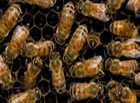Beekeeping

NAPPC National Beekeeper Survey of the Foraging Needs of Bee Colonies
The Forage, Nutrition & Roadsides Task Force is a working group of North American Pollinator Protection Campaign (NAPPC) partners tasked with supporting the development of increased acres of bee forage in key regions, working to increase access to existing potential forage for beekeepers and developing guidelines for regional seed mixes that can be used by Departments/Ministries of Transportation to effectively promote key pollinators along roadsides.
To better understand the amount of forage land needed for managed bee colonies in non-pollination settings, the Forage, Nutrition & Roadsides Task Force conducted a survey of U.S. beekeepers between October 2015 and February 2016. Beekeepers are highly knowledgeable about forage needs in their specific locations, as they are intimately familiar with the health of their colonies, the success of breeding, the amount of excess honey produced and whether supplemental feeding is required at the location. The survey asked beekeepers to consider forage needs at a specific location rather than the beekeeper’s general view of forage needs in order to obtain the most accurate information possible. The survey also asked about forage needs during winter and summer (January and July) to reflect differences in available forage.
2,250 beekeepers from 30+ states responded to the survey. Most beekeepers responded that they need 2-5 acres of forage land per colony at their southernmost yard in both winter and summer. In every state, the vast majority of beekeepers responded that they need at least 1 acre of forage per colony, with 100% of beekeepers so responding in some states. Nationally, 92% of beekeepers responded that they need at least 1 acre of forage per colony in summer.
The beekeepers were asked about the types of ecosystems upon which their managed colonies were foraging. The types of habitats were diverse, ranging from forest land to pasture land to commercial and residential properties. Additionally, there was a wide diversity in the plants used as the primary foraging source. Despite the diversity in habitats and primary forage sources, however, the average number of acres needed fell within the range of 4.2 to 6.1 acres per colony. Bees can apparently survive in many diverse habitats so long as they have sufficient foraging resources to do so.
View the full survey results here!
BEEKEEPING RESOURCES
- Your Urban Garden is Better with Bees
- Home Made Sweet Homes: how to make your own home for bees
- Bee Wise
- Bee Identification Guides
- Beekeeping 101 by GloryBee
- Link to The Story of Honey
- Guide to Bee Keeping - storing and selling honey
- Organic Gardening Resource Center
- American Beekeeping Federation- Kids and Bees
- Honey Bee Disappearances (CCD) and What You Can Do
- Mid-Atlantic Apiculture CCD information
- Link to Pollinator.com: a source for more pollinator info
- Link to USDA-ARS article: Gardening for Native Bees in North America
- Link to Mann Lake Ltd. Bee Keeping supplies
- Link to “In the Key of Bee” Bay Nature
- Link to “Buzz Pollination” Bay Nature
- Link to: "Bee Culture" The Magazine of American Beekeeping
- Selected Quotations from the National Academy of Sciences NRC Study "Status of Pollinators in North America"
- How to Reduce Bee Poisoning from Pesticides
- Pollen Nation, the Movie
- Beekeeping Resource Guide
- Florida State Beekeepers
- Beginning Beekeeping: Everything you need to know to become a beekeeper
- Book: The Practical Beekeeper: Beekeeping Naturally
- The Guide to Beekeeping for Adults and Kids
- Bees-Online: An Educational Website About Honey Bees and Beekeeping
- Backyard Beekeeping: Notes on Keeping Bees in Urban and Suburban Neighborhoods
- Beepods: Sustainable beekeeping system designed for pollination, education, and saving bees
- USDA Introduction to Beekeeping
- Bees in the Neighborhood: Best Practices for Urban Beekeepers
- Beginner Beekeeping in Australia